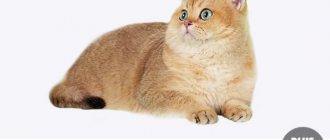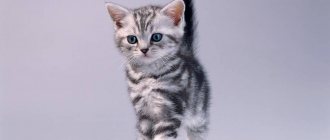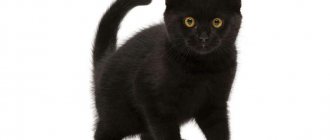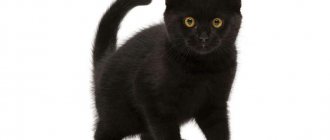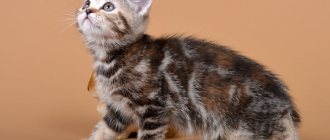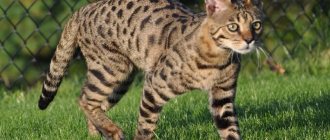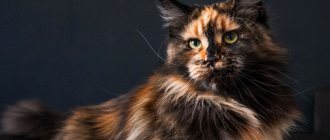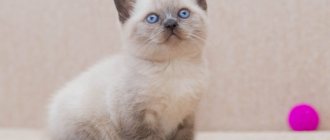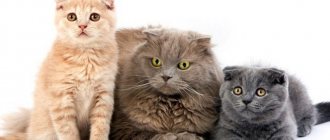Reasons for appearance
The reasons for such gender discrimination are based on differences in the chromosomal “complement” of males and females. The standard set of a female is XX, and in a full-fledged male it looks like XY: Y is a purely male chromosome that does not carry genes responsible, in particular, for color. But nature has outlined a clear mechanism according to which cat offspring inherit the colors of their parents.
Let's try to explain the complexities of color genetics in the simplest terms. Alleles—genes responsible for the inheritance of a particular color—can only be found on the X chromosome. Consider, for example, the black, red and white tortoiseshell pattern. Each X has one allele: B - black (b - chocolate) or O - red (o - cream). Two X+X in a cat is an opportunity to “place” both black and red colors (or their lightened versions) at the same time. But with only one X, the cat won’t be able to do this: either only black or only red.
Seals born from a tortoiseshell cat can be black or red - but not tricolor
The same scheme applies to other options, for example, blue-cream-white. White color is passed on to offspring differently, so such problems do not arise with it. White spotting (Ss) is the name of the gene that determines the inheritance of white color; it in no way depends on the sex of the animal.
Genetics of color
It is simply unrealistic to obtain a tortoiseshell cat through targeted breeding work. Difficulties are caused by the inability to organize chaotically located chromosomes. Therefore, even a tortoiseshell cat produces kittens with red, snow-white or black fur.
The color and pattern of a fur coat are determined genetically long before the moment of birth. Mother cats have a set of a pair of chromosomes - XX, and males - XY. The peachy-red and black shade of the coat is carried by the X chromosome. This means that in addition to white fur, females may also develop orange and charcoal fur. But males with one X chromosome, in addition to snow-white, can be either red or black.
The charcoal and red shades of cat fur are determined by the genes of the sex chromosomes - X and Y. Moreover, the latter is smaller in size and does not carry genes for red (O) or black (o) color. Therefore, only the combination XO + Xo produces tortoiseshell coloring.
Is it only cats?
There is a persistent myth that only cats can be carriers of tortoiseshell coloring - due to the fact that their sex chromosomes look like XX and make it possible for both black and red colors to appear simultaneously. It is not true. It is also not entirely true that, according to statistics, for every three thousand tortoiseshell cats, only one cat of this color is born - and that one is somehow sick, defective and practically sexless.
Tortoiseshell cat or tortoiseshell cat?
The quirks of nature are much more diverse and sophisticated than our understanding. Genetic solitaire games sometimes produce unpredictable results that are difficult to explain from a scientific point of view. For example, felinologists claim that the birth rate of tricolor cats directly depends on the region of their residence - scientists have not yet found an explanation for this phenomenon. But statistics on this matter, alas, are inaccurate—systematic studies have not yet been conducted.
Tortoiseshell cats
Contrary to popular belief, tortoiseshell - calico - cats do exist. But in order for the “female” color to appear, the cat must have a certain gene anomaly: the formula of their sex chromosome set is XXY. Such males are usually sterile, although there are exceptions.
One of the most famous calico cats was born in Germany in 2014, his name is Mesomix, he is a Maine Coon, and he is very fertile. The breeding nursery is rightfully proud of this phenomenon, from where Mesomix regularly travels for matings and examinations around the world. Scientists have found out that he is a chimera cat with an XY/XY chromosome set.
Tricolor Maine Coon Mesomix - the famous chimera cat
Quite a lot of tricolor chimera cats are known. They can be anatomically and behaviorally similar to cats, practically do not mark their territory, do not react to females in heat and, accordingly, do not give birth to offspring. Calico-colored cats are more common than “tortoises”; they are usually cryptorchids - but that’s a completely different story.
Friends of the Smith family from Great Britain vying with each other to say that happiness has come to their friends’ house since a calico cat named Jake settled there. Richard Smith promised his son a kitten as a gift, and together they went to choose a purchase. My son liked the bright calico-colored baby, and for some time the whole family was sure that they had bought a cat. Only a couple of months later, during an examination by a veterinarian, it turned out that they had made a unique acquisition - a tricolor cat. He was given a new name - Jake; The cat is absolutely healthy and cheerful. And since then, good luck has come to the Smith house.
Calico cat Jake brought good luck to his owners
Since the nineteenth century, felinologists from different countries have described many tricolor cats. Unfortunately, most of them were not only sterile, but also did not live long, since along with the genetic mutation they received various serious diseases.
Toyger.
American breed. The name can be translated as toy tiger. The idea of breeding the breed appeared in the 1980s. In 1993, the first representatives were already presented to the International Cat Association, and in 2007, Toygers became a full-fledged champion breed.
These are short-haired cats with a characteristic brindle coloration. They are distinguished by their extraordinary intelligence and calm, balanced character. They are sociable, affectionate, get along easily with other animals, and get along well with children. Monogamous. There is an opinion that as a result of selection, toygers have lost such an important instinct as orientation, so do not lose your pet, unlike other cats, he will not be able to find his way home.
The cost of a show class kitten is about 60 thousand rubles, for breeding - up to 200 thousand.
Kinds
Felinologists distinguish two main varieties: patchwork and scaly.
Patchwork
Another name is calico. The English word "calico" means calico fabric. Calico combines clear spots of rich black, red and pure white colors and this really resembles a chintz blanket sewn from scraps.
Scaly
Another name is torti. A chaotic combination of colors is assumed here, for example, blue and cream or black and red. The spots are small, like scales, hence the name. Their boundaries are unclear, shades can flow into one another.
Skookum.
The first results on breeding this breed were obtained in 1996 by crossing cats of the Munchkin and La Perm breeds. After this, work was carried out for another 10 years to identify and consolidate breed traits. The result was small cats with long wavy hair. They are sometimes called dwarf la-permas.
Cheerful and lively, loving and affectionate. Agile and dexterous, despite their short legs. Surprisingly silent and taciturn.
The breed, although recognized, is experimental, and therefore very rare, and therefore very expensive.
Varieties
It’s simply hard to imagine a more bizarre color. Nature, like a careless artist, mixes colors on a palette, and sometimes jokes cheerfully, applying them to cats’ fur coats. Depending on the size, shape and location of the color spots, different types of tortoiseshell colors are classified.
Why is the color called tortoiseshell? To understand this, just look at the hair combs, which were made from tortoise shell and were once at the height of fashion.
The patterns on the tortoiseshell comb are reminiscent of the bizarre colors of turtle cats.
Full
| Color name | Wool colors | Peculiarities | Eye color |
| Tortoiseshell black | Red and black | areas with red pigment are lightened in places | dark yellow or dark copper |
| Turtle chocolate | chocolate and red | pigment saturation is usually uniform | yellow, orange or copper |
| Turtle cinnamon | red and cinnamon | color is not recognized by breed standards | yellow and dark yellow |
Tortoiseshell colors can be either spotted or striped. It is possible, although rare, to have a combination of both. It becomes the result of the interaction of “color” genes with the agouti gene (A). This is how the valuable torby color appears when the tortoiseshell spots form a tabby pattern.
The Torby color is rarely seen and is highly valued.
One color cannot combine full and diluted colors - black-cream, red-blue and similar mixes are signs of genetic mutations.
Diluted
| Color name | Wool colors | Peculiarities | Eye color |
| Tortoiseshell blue-cream | cream and blue | rare and quite sought after color | copper, green or orange |
| Tortoiseshell lilac-cream | lilac and cream | looks especially good on long thick coats | copper, green or orange |
| Tortoiseshell cream fawn | cream and fawn | color is not recognized by breed standards | green or dark yellow |
Tortoiseshell colors that have small white spots are called piebald. Such options are classified in the same way as full and diluted - only in each specific case, “with white” is added to the name of the color: for example, “cinnamon tortoiseshell with white,” tortoiseshell lilac-cream with white, etc.
Diluted tricolor colors look elegant
Colors with large areas of white are classified into a separate group called "calico". In such cases, up to half of the animal’s fur can be painted white: usually the lower part of the body along with the paws. The skin under the white fur is pink. The red and black spots on the calico's coat differ from the usual tortoiseshell color by having clearer contours and richer pigment.
Calico full
| Color name | Wool colors | Peculiarities | Eye color |
| Calico black | black, red and white | areas with red pigment are lightened in places | dark yellow or dark copper |
| Calico chocolate | chocolate, red and white | pigment saturation is usually uniform | copper, green or orange |
| Calico cinnamon | cinnamon, red and white | color is not recognized by breed standards | green or dark yellow |
With the Calico color, the black areas of the coat are uniformly colored, and the cream or red spots may be brighter in places and lighter in others; this gradation is much more noticeable than with a tortoiseshell color.
Calico varieties look brighter than tortoiseshell colors
Calico diluted
| Color name | Wool colors | Peculiarities | Eye color |
| Diluted Calico | white, cream and blue | rare and quite sought after color | copper, green or orange |
| Lilac-cream with white | white, lilac and cream | looks especially good on long thick coats | copper, green or orange |
| Cream fawn with white | white, cream and fawn | color is not recognized by breed standards | green or dark yellow |
The Calico color looks very elegant, bright and therefore very popular. It is also often called patchwork or chintz.
Golden colors
The golden series of colors of British cats is divided in the same way as the silver. This type was developed relatively recently, which explains many controversial issues in the classification. In the golden variation there cannot be red and cream shades of wool. The undercoat of golden cats is not white, like silver cats, but a rich, warm cream or apricot color. The hair has black (optionally: brown) tipping on the head, back, tail and sides. The cat's chin, ears, chest and belly are soft apricot, nose? brick, paw pads dark (brown to black). The tipping on the tail is deeper than on the rest of the body. The eyes must be green. The mirror of the nose is reddish in color. Tabby markings are acceptable on kittens. In adults? the letter "M" on the forehead, as well as closed rings on the legs and tail and an open necklace.
Main breeds of tortoiseshell cats
The X and Y chromosomes are responsible for determining sex in cats, as in humans. The X chromosome is responsible for the inheritance of color.
For such a combination of coat colors, two X chromosomes are needed, and this is normally only possible in a female. The male has a normal cat genotype - XY. Tricolor and tortoiseshell cats are found, but this is a consequence of a genetic disorder. But they will have the XXY genotype.
Tortoiseshell cat
Interesting! It is impossible to predict whether a tortoiseshell kitten will be born to a similar cat. A litter may include a black male kitten and a red female kitten.
The following describes the most famous breeds whose coat color resembles that of a tortoiseshell.
Sphinxes
The tortoiseshell sphinx is quite rare. This color is found in the Canadian variety of this breed. Sphynxes are sophisticated and refined creatures, the cat weighs up to 4 kg, the male weighs no more than seven. The coat is completely absent.
The life expectancy of sphinxes is about 15 years, but with proper care.
The tortoiseshell color of the Sphynx cat has several varieties:
- lilac with the addition of cream;
- red chocolate;
- black-red;
- creamy blue.
Only cats are painted in this mixture of colors.
Tortoiseshell Sphynx
British
The plush fur of British cats carries different variations of “tortoiseshell” colors. The following combinations occur.
Classic common ones:
- black with red;
- lilac-cream;
- cream and blue.
Less common are British fawn (rich beige) with soft cream and cinnamon (the color of a cinnamon stick) with red splashes. Often there are combinations of tortoiseshell color with tabby (striped).
Interesting! Only cats appear this color. A tortoiseshell British cat can be born, but he will be sterile from birth.
British tortoiseshell cat
Kurilian Bobtail
Short-tailed cats with a tri-colored or blue-cream tortoiseshell coloration, come in odd-eyed, yellow-eyed and green-eyed varieties. Lilac, chocolate and fawn colors are prohibited by the breed standard. The nose and feet are gray or black.
The tortoiseshell Kurilian Bobtail should not have a coat in diluted shades of black
Japanese Bobtail
The traditional tricolor color of bobtail cats is a combination of red, black and white (except for lilac and chocolate variations). The eyes can be multi-colored (golden and blue) or all shades of orange-yellow and green. The skin of the nose and paw pads is often pink, but sometimes black.
Japanese bobtails are not allowed to have lilac and chocolate colors.
Maine Coon
Huge cats with luxurious semi-long hair, decorated with spots of various colors that smoothly flow into each other. Combinations of bright red and black with the addition of white are more common, less often diluted. The color of the skin on the soles of the paws and nose corresponds to one of the solid tones that make up the color, the eyes are greenish or yellow-orange.
Tortoiseshell Maine Coons are very common
Turkish van
On the snow-white body there are spots of black-blue and red-cream range; they should occupy no more than 15% of the cat’s body area. Eye color - blue, amber or different. The pads of the feet are pink and may have colored spots on them. The skin of the nose is deep pink.
Tortoiseshell Vans have colored spots on a white background
Persian breed
Long-haired tortoiseshell cats look very interesting, because in this case not only the pattern, but also the texture of the hairs is taken into account. In Persian cats, the tricolor sections of the coat are intricately mixed, and the hairs can have different shades along the entire length. Turtle Persians typically have beautiful dark orange eyes that look like jewels against their colorful fur.
Longhaired Persian cat "tortie"
Turkish Angora
Despite the fact that Turkish Angoras were bred as completely snow-white cats, over time, breeders introduced various types of colors, including tortoiseshell. Among Angora cats, the “tortoise-on-white” type is especially common, with the light coat having a particularly vibrant whiteness. The colored areas of the fur coat are usually bright and saturated.
Turkish Angora Tricolor
Cornish Rex
Curly-haired Cornish, which have the most delicate fur covered with curls, also represent a breed group, which according to the standard includes tortoiseshell color. Especially among Cornish Rexes, variations in coloration “turtle on white” are valued, when the lower part of the animal’s body is covered with snow-white fur, and on top there are red and black spots.
Tricolor Cornish Rex kitten
Neva Masquerade
Very dark pointing markings on the paws, muzzle, tail, as well as a beige or soft cream body. Chaotic spots from dark red to rich cream colors, sometimes the points are barely distinguishable. The nose and pads are dark brown, the irises of the eyes are painted in blue tones.
Neva Masquerade in tortoiseshell color must have blue eyes
Scottish lop-eared
Funny cats, seemingly devoid of ears, in tortoiseshell color are especially reminiscent of a forest owl. This breed is related to the British and therefore has similar types and shades of tricolor. The coat of a Scottish cat can have both cold charcoal and warm chocolate shades. More common are motley cats, the “torti” subspecies, with very rich, bright coat pigments.
Scots Fold, "torty" color
Orientals
The tortoiseshell color is one of the most popular in the rich palette of the Oriental breed - the standard allows for about four dozen color variations for these original animals. Smart and beautiful oriental cats are extraordinary in everything, from appearance to character . Therefore, the bizarre tortoiseshell patterns simply fit perfectly into the image of the breed - there is no more unusual color in nature.
Oh, who has such big ears and such a bad mood?
Norwegian
Norwegian forest cats, according to many, are the most spectacular representatives of the tortoiseshell color. Animals with the “turtle on white” type are more common. Thanks to their long, very lush and rich coat, Norwegian Forest cats boast unusual color transitions and layers of shades.
Norwegian forest turtle
Outbred
The tortoiseshell cat can be found everywhere: both in a rural farmstead and on the streets of a big city. Despite the fact that many people are happy to take tricolor kittens into their homes, many of them remain strays. Don't pass by this colorful bundle of fluffy happiness - perhaps with his appearance in your life it will change for the better.
Beauty does not require documents
It doesn’t matter whether the cat has documents - outbred “tricolors” can boast not only beauty, but also intelligence, good health and strong genetics. It is in litters of yard “turtles” that most cats are born that inherit their mother’s color.
If you're lucky, there may be several "turtle" kittens in one litter.
Light or white cat
Lighter colored Maine Coons are suitable for calm people. White cats are always very energetic. They easily convey their good mood to their owners. Owners of light-colored cats are smiling, emotional and very active. In England, white cats are even sold in special pharmacies - for tone. By the way, healers advise everyone who has vision problems to stroke the tail of a white cat more often.
Features of character and behavior
Of course, much in a cat’s character depends not on its color, but on its breed, genetics, living conditions and other factors. But in the behavior of most tortoiseshell cats, many similarities can be observed, which allows us to say: color also matters!
Tri-colored cats are unusually flexible and friendly - you can always come to an amicable agreement with them. At the same time, they are proud, independent, know what they want, and will not do what they do not like. They are persistent, and sometimes even too stubborn, and always try to get their way. However, the “turtles” are not doing this out of harm; they have a heightened sense of justice, which they try to restore wherever they are present.
A regal appearance requires aristocratic manners
The only authority for such a cat is its beloved owner. Only to him can she allow a lot and forgive him. But it is better for a stranger not to show familiarity and disrespect for such a royal person - he will instantly receive a harsh rebuff. Veterinarians say that tortoiseshell cats behave worse during appointments than all the others: well, they don’t like that the doctor takes liberties...
Of the obvious shortcomings of tricolors, only one can be named - they are poorly accustomed to the tray. If your pet has chosen a certain corner of the house to relieve itself, no force can force her to change the place for the toilet - it will be easier and more effective to move the litter tray to where she likes it. This is indeed a problem that many turtle owners complain about. Well, don’t forget to change the filling more often - a dirty tray is not suitable for royalty!
Tortoiseshell cats are caring mothers
Those who are lucky enough to own a calico cat admire its excellent maternal qualities - it turns out that color can also influence this.
Lykoi.
If the previous breed of cats evokes associations with elves, then Lykoi - with werewolves. The breed was registered in 2012. Like all the previous ones, it was bred by American breeders. Cats of this breed have very rare fur of a characteristic color and an extraordinary character.
You can read more about this unique breed in the article Meet Likoy, a werewolf cat , where you will also find a series of original photographs taken by one of the breeders who were the breeders of this breed.
Mystical purpose
The population of different countries treats these animals differently. This is understandable: different cultures, different religions, different life interests. And what’s really surprising is that the attitude towards three-colored graceful creatures is exactly the same everywhere. I wonder why? What lies at the basis of such agreement in relation to the smaller mustachioed brothers? Cultural positions, moral and ethical standards converge at some point, and a rapprochement of peoples occurs.
The fact that feline aristocrats are endowed with different properties and given additional mystical capabilities is explained by their great rarity. Cats attract money into the house and thereby solve issues of well-being and wealth; with the help of a cat you can easily get rid of evil spirits, because this evil spirit generally cannot stand cats.
This is not a complete list of cat talents that people have endowed them with. Tortoiseshell color has nothing to do with tortoiseshell character. Tricolors are mobile, intelligent, and capable of action.
Rich is God's gift to the Russians
In Ancient Rus', animals had an additional wonderful name. They were lovingly and with a great deal of hope for all the best in life called rich people. Someone will think that the name comes from the word “wealth”, but this is not so far from the truth.
The Old Russian name for miracle cats “bogatka” comes from the word “God”. This emphasized some of the feline capabilities that God himself endowed them with.
Americans want to live well
In America, the content of the attitude towards a family friend is filled with a certain amount of practicality. Americans are sure that a tricolored, mustachioed family friend will certainly bring good luck and wealth, and will help you find and keep a well-paid job. If a person saw a tortoiseshell cat in a dream, you can be sure that happiness and good luck await you. The sign has been living in the beliefs of the peoples of the world for many centuries.
Friend of the English family
In Great Britain, the mysterious tricolor joy and comfort of the family is intended to preserve and protect the home and family from evil spirits. The British have a slightly different approach to seeing their role in family life. Tortoiseshell cats are given a special role. They are so beautiful and useful that the rest of the cat tribe is nothing compared to them. They are assigned the role of mouse exterminators. These non-tricolor fighters love only the house and themselves in this house. They do not pay any attention to the owner. A tortoiseshell cat can become a true friend to the owner of the house; comfort and tranquility, peace and harmony will reign in the house.
The Japanese worship!
The tricolor miracle has firmly taken its place in the cultural traditions of Japan. This is confirmed by the cat figurine. If you decide to purchase a figurine in Japan, you should know that there is nothing random about the figure embodied in the figurine. The tilt of the head, the size of the spots, their location - all this is of particular importance.
To choose the right figurine of an aristocrat with a tortoiseshell color, you will need to consult experts in Eastern culture. The Japanese have surpassed all nations of the world in endowing such representatives of the cat family with various positive properties. They elevated them to a symbol of the entire nation, and even called them in their own way: manekki-neko.
The Japanese are sure that three-colored creations of nature are cosmic messengers. They were sent to the planet to perform a special mission. When such a creature lives nearby, all family members will be protected from problems.
Tricolor and sailors
Swimming is reliably protected from destructive storms if they are accompanied by a tortoiseshell cat. If a sailor dreams about it, the storm will certainly stop. It is for this reason that captains carry photographs depicting a three-colored delicate creature across the seas and oceans. Like the entire cat species, tricolors are gentle, affectionate, clean, excellent mothers - like all relatives with other colors.
